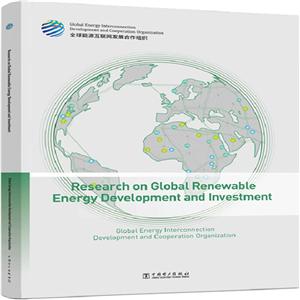-
>
公路車寶典(ZINN的公路車維修與保養(yǎng)秘籍)
-
>
晶體管電路設(shè)計(jì)(下)
-
>
基于個性化設(shè)計(jì)策略的智能交通系統(tǒng)關(guān)鍵技術(shù)
-
>
花樣百出:貴州少數(shù)民族圖案填色
-
>
山東教育出版社有限公司技術(shù)轉(zhuǎn)移與技術(shù)創(chuàng)新歷史叢書中國高等技術(shù)教育的蘇化(1949—1961)以北京地區(qū)為中心
-
>
鐵路機(jī)車概要.交流傳動內(nèi)燃.電力機(jī)車
-
>
利維坦的道德困境:早期現(xiàn)代政治哲學(xué)的問題與脈絡(luò)
全球清潔能源開發(fā)與投資研究(英文版) 版權(quán)信息
- ISBN:9787519850920
- 條形碼:9787519850920 ; 978-7-5198-5092-0
- 裝幀:一般膠版紙
- 冊數(shù):暫無
- 重量:暫無
- 所屬分類:>>
全球清潔能源開發(fā)與投資研究(英文版) 本書特色
給出了全球較完整的體系化清潔能源資源評估方法與結(jié)果,提出了基地開發(fā)方案,并且展示了量化的技術(shù)經(jīng)濟(jì)指標(biāo),對于讀者而言兼顧科普性、通識性以及專業(yè)性,滿足不同讀者的信息獲取需求。
全球清潔能源開發(fā)與投資研究(英文版) 內(nèi)容簡介
本報(bào)告是《優(yōu)選清潔能源開發(fā)與投資研究》的英文版。
本報(bào)告作為系列成果中的總報(bào)告,一方面系統(tǒng)闡述了優(yōu)選清潔能源資源評估與基地?cái)?shù)字化宏觀選址的技術(shù)路線和模型方法;另一方面立足優(yōu)選視角,基于各大洲清潔能源資源評估和大型基地的深入分析,展示了優(yōu)選清潔能源開發(fā)與投資的研究成果。
報(bào)告的章和第2章是研究的方法與數(shù)據(jù),全面闡述了清潔能源資源評估和大型清潔能源發(fā)電基地宏觀選址的方法體系、基礎(chǔ)數(shù)據(jù)和數(shù)學(xué)模型。第3-5章系統(tǒng)展示了基于數(shù)字化方法的優(yōu)選水能、風(fēng)能和光伏資源評估與大型基地開發(fā)的研究成果。第6章是基地電力消納和外送方案研究,綜合分析了各洲電力供需趨勢,提出了大型基地的送電方向與輸電方式。第7章總結(jié)了優(yōu)選清潔能源開發(fā)的投融資政策環(huán)境,提出了促進(jìn)各大洲清潔發(fā)展的投融資建議。
全球清潔能源開發(fā)與投資研究(英文版) 目錄
1.1 Technical Route??002
1.1.1 Assessment on Wind Energy Resources??003
1.1.2 Assessment on Wind Energy and Solar Energy Resources??004
1.2 Data and Calculation??008
1.2.1 Basic Data??008
1.2.2 Computing Technology??010
1.3 Assessment Model of Hydroenergy Resources??013
1.3.1 Theoretical Potential??013
1.3.2 Technical Potential Installed Capacity??014
1.3.3 Economic Potential Installed Capacity??015
1.4 Assessment Model of Wind Energy Resources??016
1.4.1 Theoretical Potential??016
1.4.2 Technical Potential Installed Capacity??016
1.4.3 Economic Potential Installed Capacity??021
1.5 Assessment Model of Solar Energy Resources??029
1.5.1 Theoretical Potential??029
1.5.2 Technical Potential Installed Capacity??031
1.5.3
2
Economic Potential Installed Capacity??036
Macro Site Selection Method of Renewable Energy Bases??037
2.1 Technical Route??038
2.1.1 Ideas of Study??039
2.1.2 Data and Algorithm??041
2.2 Quantitative Judgment Model for Selection of Bases??044
2.2.1 Quantitative Model??044
2.2.2 Example Analysis??047
2.3 Digital Site Selection of Hydropower Stations??050
2.3.1 Method Process??050
2.3.2 Extraction of Digital River Networks??051
2.3.3 Selection of Planned Reaches??053
2.3.4 Analysis of Restrictive Factors??054
2.3.5 Proposed Layout of Hydropower Station??054
2.3.6 Calculation of the Main Parameter Index??055
2.3.7 Drawing of Result Figures and Tables??056
2.4 Digital Site Selection of Wind Power Stations??057
2.4.1 Method Process??057
2.4.2 Analysis of Wind Energy Resource Data??057
2.4.3 Analysis of Restrictive Factors??058
2.4.4 Equipment Selection and Automatic Layout Scheme??059
2.4.5 Calculation of the Main Parameter Indicator??063
2.5 Digital Site Selection of Photovoltaic Power Stations??065
2.5.1 Method Process??065
2.5.2 Analysis of Solar Radiation Data??065
2.5.3 Analysis of Restrictive Factors??066
2.5.4 Equipment Selection and Automatic Arrangement??066
2.5.5 Calculation of the Main Parameter Indicator??068
2.6 Investment Estimation Method of Renewable Energy Base??070
2.6.1 Model and Method??071
2.6.2
3
Results and Verification??075
Hydroenergy Resources Assessment and Development??079
3.1 Basic Conditions??080
3.1.1 Distribution of Water Systems??081
3.1.2 Hydrological Data??084
3.1.3 Land Covers??088
3.1.4 Geological Conditions??089
3.2 Resource Assessment??096
3.2.1 Dverview of Hydroenergy Resources??096
3.2.2 Assessment Results??096
3.2.3 Assessment Case of River Basins??102
3.3 Base Development??106
3.3.1 Development Status??106
3.3.2 Layout of Bases??108
3.3.3
4
Case of Site Selection of Bases??113
Wind Energy Resources Assessment and Development??123
4.1 Basic Conditions??124
4.1.1 Distribution of Wind Speeds??125
4.1.2 Land Covers??125
4.1.3 Distribution of Conservation Areas??129
4.1.4 Transportation Facilities??132
4.1.5 Grid Facilities??136
4.2 Resource Assessment??142
4.2.1 Theoretical Potential??142
4.2.2 Technical Potential Installed Capacity??143
4.2.3 Development Cost??148
4.2.4 Assessment Case of Countries??152
4.3 Base Development??155
4.3.1 Development Status??155
4.3.2 Layout of Bases??157
4.3.3
5
Case of Site Selection of Bases??169
Solar Energy Resources Assessment and Development??175
5.1 Basic Conditions??176
5.1.1 Distribution of Global Horizontal Irradiance??177
5.1.2 Land Covers??177
5.1.3 Distribution of Terrains??180
5.2 Resource Assessment??186
5.2.1 Theoretical Potential??186
5.2.2 Technical Potential Installed Capacity??187
5.2.3 Development Cost??192
5.2.4 Assessment Case of Countries??196
5.3 Base Development??199
5.3.1 Development Status??199
5.3.2 Layout of Bases??201
5.3.3
6
Case of Site Selection of Bases??212
Outbound Transmission of Large Renewable Energy Bases??217
6.1 Forecast of Electricity Demand??218
6.2 Deep Electric Energy Substitution??223
6.2.1 Hydrogen Production and Hydrogen Energy Utilization for Clean
Electricity??223
6.2.2 Seawater Desalination and Ecological Restoration??228
6.3 Backbone Grid of Global Energy Interconnection??230
6.3.1 Power Delivery Direction??230
6.3.2 Target Grid??231
6.3.3 Construction Scheme for 2035??235
6.4 Asia??237
6.4.1 Power Delivery Direction??237
6.4.2 Power Transmission Scheme??238
6.5 Europe??239
6.5.1 Power Delivery Direction??239
6.5.2 Power Transmission Scheme??240
6.6 Africa??241
6.6.1 Power Delivery Direction??241
6.6.2 Power Transmission Scheme??242
6.7 North America??243
6.7.1 Power Delivery Direction??243
6.7.2 Power Transmission Scheme??244
6.8 Central and South America??245
6.8.1 Power Delivery Direction??245
6.8.2 Power Transmission Scheme??246
6.9 Oceania??248
6.9.1 Power Delivery Direction??248
6.9.2
7
Power Transmission Scheme??249
Policy Environment and Investment and Financing Suggestions??251
7.1 Overview of Global Investment and Financing Policies??252
7.2 Policy Environment and Investment and Financing Suggestions for Each Continent??257
7.2.1 Asia??257
7.2.2 Europe??260
7.2.3 Africa??262
7.2.4 North America??265
7.2.5 Central and South America??267
7.2.6 Oceania??269
EPILOGUE??271
Appendix Key Algorithms of Geographic Information Operation??273
全球清潔能源開發(fā)與投資研究(英文版) 作者簡介
全球能源互聯(lián)網(wǎng)發(fā)展合作組織(簡稱合作組織),是由致力于推動世界能源可持續(xù)發(fā)展的相關(guān)企業(yè)、組織、機(jī)構(gòu)和個人等自愿組成的國際組織。注冊地設(shè)在北京。合作組織的宗旨是推動構(gòu)建全球能源互聯(lián)網(wǎng),以清潔和綠色方式滿足全球電力需求,推動實(shí)現(xiàn)聯(lián)合國“人人享有可持續(xù)能源”和應(yīng)對氣候變化目標(biāo),服務(wù)人類社會可持續(xù)發(fā)展。合作組織將積極推廣全球能源互聯(lián)網(wǎng)理念,組織制定全球能源互聯(lián)網(wǎng)發(fā)展規(guī)劃,建立技術(shù)標(biāo)準(zhǔn)體系,開展聯(lián)合技術(shù)創(chuàng)新、重大問題研究和國際交流合作,推動工程項(xiàng)目實(shí)施,提供咨詢服務(wù),引領(lǐng)全球能源互聯(lián)網(wǎng)發(fā)展。
- >
煙與鏡
- >
大紅狗在馬戲團(tuán)-大紅狗克里弗-助人
- >
二體千字文
- >
山海經(jīng)
- >
龍榆生:詞曲概論/大家小書
- >
詩經(jīng)-先民的歌唱
- >
【精裝繪本】畫給孩子的中國神話
- >
羅曼·羅蘭讀書隨筆-精裝















